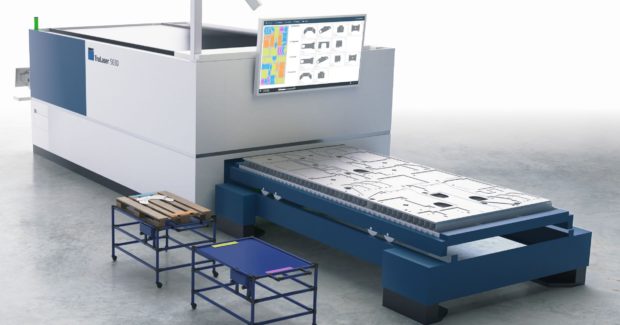Data Driven Production, from Order Entry to Execution
Break data into small segments in order to develop good data, resulting in better solutions.
Posted: July 8, 2021
THE CUTTING EDGE
BY TOM BAILEY
Most people working in manufacturing would agree that factories need information flow to operate just like any other business. Without work instructions and drawings, manufactured products do not get made correctly, even if you do have the best people, tools and materials available. Without a maintenance schedule for a piece of machinery, the odds of that equipment running well in the long-term are seriously reduced. Without correct safety signs in place, people can’t be sure when they are entering an area where personal protective equipment is needed, and lives could even be at risk. Most of these kinds of information sharing are common to all types of factories, from small to large, and from specialized to general purpose. And likewise, most fabricators would probably agree with the idea that the effort and energy of a manufacturing enterprise should be driven by data.
Considering that general sentiment, it can be a little surprising how much data is also lost, overlooked or misunderstood every day in these very same businesses. Each of those unused or misused data points is an opportunity to capture more efficiency in a factory setting. In that context, investing in the ability to manage data more effectively can deliver added production value as surely as investing in plant and equipment. Because there is data behind every aspect of a manufacturing enterprise, it can seem a little daunting to dive into: Where do we focus our data collection effort? What data should we capture, and what data can we safely disregard? Once we figure out how to collect data on an area of the manufacturing process, how do we analyze it and implement positive changes?
Like most undertakings, the goal of getting the most out of the available data can be broken down into small steps and taking a bunch of small steps will add up to a great deal of distance covered. For one example, we can begin with what, for most manufacturers, would be the beginning of the order process: quoting or estimating a new job. Regardless of whether you are developing a new product line or bidding on a fixed contract, you need an idea of what it costs to make something. Every manufacturer has devised some method for calculating, based on a product concept, what the cost to produce would be. Often though, the methods are based on inaccurate or outdated information. To be sure of a margin, deliberate buffers need to be baked into the cost cake. It’s not an ideal situation, not least because uncertainties in the math like that can come back to cut us both ways. Overestimating the cost can cause us to become uncompetitive, and underestimating can cause us to lose money.
Good data (and use of it) can bring us to a better solution. Some companies developing software to drive machine tools have realized that, because the software can potentially have fully accurate data about machine processes, it is also possible to use that data to calculate the material utilization, setup time, run time, and even hourly operational and personnel costs for a particular job. An estimator working on a new project hands off the CAD drawings and quantities to a software calculation module. The calculation module is armed with access to the rules and processes for producing those parts on machines, provided by the software developer. It is also equipped with values (provided by the user) for local consumable costs like price per kilowatt-hour of electricity; per unit of bottled oxygen, nitrogen or argon used; price per hour of use for consumable materials on the shop floor like gloves, welding wire and grinding media; and even the hourly costs of the equipment operators and the factory floor space. The calculation module can return an accurate cost to produce based on the drawings within moments and can even show how the cost changes with increasing volume.
MAKING THE MOST OF THE ORDER-TO-PRODUCTION PHASE
Another area where better data management can yield quick dividends is in the order-to-production phase. This picture can look different depending on the business, but typically involves entering an order into a planning system (ERP or MRP, for example). Assuming the raw materials are on hand, the order goes to programming for any CNC machine steps involved. From there the order is handed off to the factory floor and routed through the required production steps. From the person in charge of executing the order initially to the person running the cutting machine where the order will start to become reality, there may be several other individuals in between. Each of them might need to receive the order and hand it on in a specified way. There might be paperwork involved, or data entry at a computer, or both; that processing work might even have to happen multiple times before the operator on the floor gets the work instructions. What seems like it should be a simple concept (We have metal! We have an order for parts made from metal! Let’s get to work!) ends up requiring a series of hoops to be jumped through before any production happens.
Just as with estimating, there are smart software solutions available now that can connect all these steps and make them more or less seamless. Instead of entering an order into an ERP and then manually handing the order details off to another person to be entered into a CAD/CAM system and prepared for the factory, a factory management system receives the order entered into the ERP and takes over the hand-off to the programming system. It’s also possible to have the factory management system automatically trigger the CAM system to generate working machine tool programs for the order. From there, the factory management system can push the NC code directly to the machine controls on the factory floor. The factory management system can make it possible for a decision maker to directly change the priorities of the factory within moments and ensures that accurate and up-to-date production orders are disseminated instantly to every team member that needs them.
Optimizing information flow from the supporting organization in the front office to the implementing organization on the factory floor can directly reduce effort and cost for the whole team. It also brings a host of other benefits: Shorter lead-times, reduction in mistakes and greater flexibility being just the most obvious.
This article addresses only a couple of ways to go about it; there are probably any number of places you can identify where important data should be getting turned over and isn’t, or is getting turned over but not quickly enough, or maybe it’s just too manual of a process at the end of the day and needs to become more automatic. After you’ve optimized the information links from the front office to the factory floor, you might turn your attention to optimizing the flow of useful information back from the shop floor to the office.

















